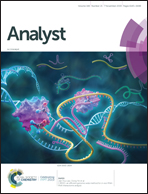Cognitive spectroscopy for wood species identification: near infrared hyperspectral imaging combined with convolutional neural networks†
Abstract
From the viewpoint of combating illegal logging and examining wood properties, there is a contemporary demand for a wood species identification system. Several nondestructive automatic identification systems have been developed, but there is room for improvement to construct a highly reliable model. The present study proposes cognitive spectroscopy that combines near infrared hyperspectral imaging (NIR-HSI) with a deep convolutional neural network approach. We defined “cognitive spectroscopy” as a protocol that extracts features from complex spectroscopic data and presents the best results without human intervention. Overall, 120 samples representing 38 hardwood species were scanned using an NIR-HSI camera. A deep learning prediction model was built based on the principal component (PC) images obtained from the PC scores of hyperspectral images (wavelength range: 1000–2200 nm at approximately 6.2 nm interval). The results showed that the accuracy of wood species identification based on 6PC (PC1–PC6) images was 90.5%, which was considerably higher than the accuracy of 56.0% obtained with conventional visible images.



 Please wait while we load your content...
Please wait while we load your content...